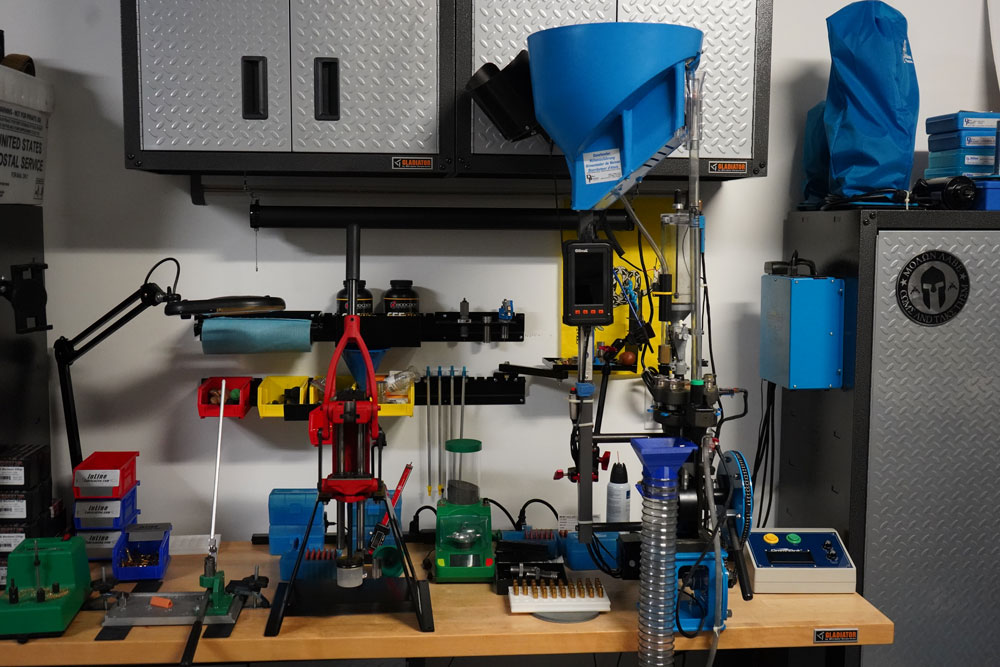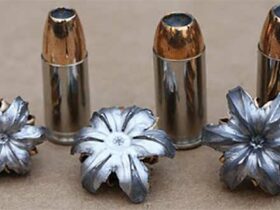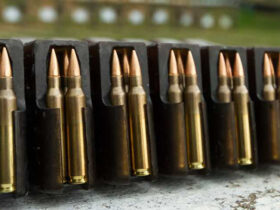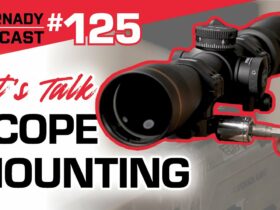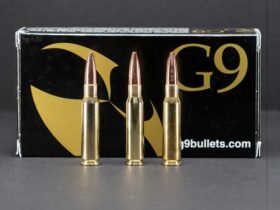In my first article of this five-part series, I introduced the four different types of reloading presses popular today. If you haven’t read it, it might be worth your while as it’s a decent overall intro to reloading, both the process and the equipment needed.
You will find that, of those four types of presses, three might interest you — unless you want to load right at your shooting bench at the range. That’s a different proposition. If you are talking about bench-mounted presses, you will find that there are single-stage, turret, and progressive presses. Here are the differences:
- Single-Stage presses hold one die at a time. You screw a die into the press, perform that die’s function on all your cases, then switch dies. You will only produce loaded ammo after using the final die of the set.
- Turret presses have a tool head that rotates (either manually or automatically) and holds all the dies at once, usually three or four stations. But you can place only one case at a time in the shell holder. This way, the turret head rotates with each pull of the handle. It takes as many pulls of the handle as you have dies in place to produce a loaded round.
- Progressive presses are different. They use a tool head that holds all the dies, like the turret press. But, they have a rotating shell plate that has as many stations as there are die mounts in the tool head. I own a Dillon Precision XL750 press, where I load 9mm and .223. Since the basic progressive process is much the same for all progressive presses, I will use it as our example.
How Does a Progressive Reloading Press Work?
An empty case drops from the (optional in some cases) electric case feeder down the tube and is shuttled into station 1: the shell holder. You then pull the handle down. The case is resized and deprimed with that one action.
You then pull the handle up and the first case goes to station 2: priming and powder dispensing. Moving the handle up, you will seat the new primer and drop the powder charge in the case.
Station 3 on my press is empty, but that is where a powder check station could go. Move the handle up and down to station 4.
On to station 4 — bullet seating and crimping. After these are done, the handle goes up and down, and the case is moved to station 5, where it is “kicked out” and dropped into an attached collection box for loaded rounds. Remember that, with all the stations occupied, each down/up movement of the handle produces a loaded round.
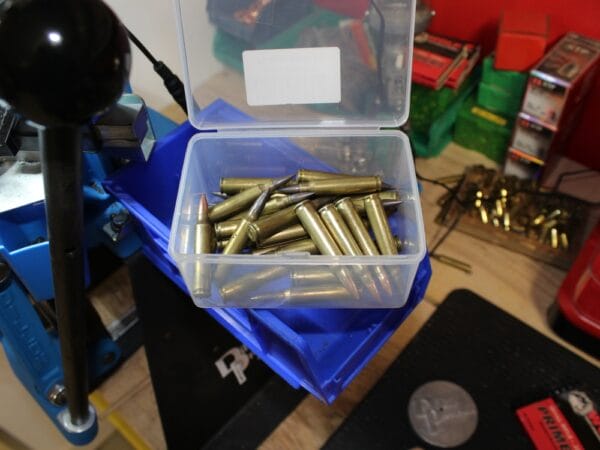
That’s it, in a nutshell. The main difference between a turret press and a true progressive press is that once all the stations are full of cases, the progressive press will produce a loaded round with each handle pull. The turret press requires as many handle pulls as there are stations to produce one round.
A good reloader can load upwards of 500 rounds per hour on a progressive press once all the components are within reach and the press is set up.
So… what’s not to like? Let’s look at a few pros and cons of progressive presses.
Pros
- Speed. Loaded ammo accumulates very quickly
- Strength. Progressive presses tend to be built very strongly
- Rigid. No variations come into play once the press is set – nothing to get out of adjustment
- Automation. Processes like case feeding, powder dispensing, primer seating, etc. tend to be more automated than on other presses
Cons
- Cost. Progressive presses typically cost well more than other types
- Setup. Setting one up is involved and will take some time.
- Glitches. If you get a stuck primer in the feed tube or other issue, your whole operation comes to a halt until you correct it.
The above reflects some general issues that I’ve run into on my Dillon. I admit that I was not exactly an expert when I started with my press, but we understand each other a little better now.
I must admit that, once everything is going, the press’s production is slicker than STP on a glass door knob. It’s easy to crank out dozens of rounds in one sitting. Make sure you have extra primer tubes loaded and ready to go and that your bullets, cases, and powder are handy for refills.
Live Inventory Price Checker
What You Should Look For In A Progressive Press
I’ve done a lot of research on progressive presses. I own and use one, and I have a few ideas concerning them. I’ve walked the reloading press road since about 1978 and have some years of experience where they are concerned. I say this not to imply that I am the great “Press Guru” or anything of that sort — I’m still learning and make plenty of mistakes. I say it only to show you that I’ve worked a few different press handles up and down for a few decades and have come to a couple of conclusions.
- If you are a brand-new reloader, don’t buy a progressive press. Start with a single-station, or at most, a simple turret press like Lee makes. Progressive presses are wonderful, but they demand a level of knowledge and proficiency that a newbie may not possess. Learn the process first, then add the speed and complexity later.
- Five stations is the minimum number that you should consider. If you decide to seat your bullets on one station and crimp on the next, you will need an extra station. Technically, four should work but I like having options for future operations.
- Consider buying a reloading kit, or at least purchase optional equipment upfront. It can be cheaper to do that. One suggestion I’ll make where kits are concerned has nothing to do with the press itself but concerns the powder scale. Many kits come with balance-beam scales. After reviewing almost 20 scales, I’ve concluded that digital is the way to go. A simple, $35 RCBS Pocket scale will be quicker than a mechanical one.
- When you do “graduate” to a progressive press, watch videos on setting it up. I have the Dillon XL750 and have watched many Dillon Precision videos on YouTube featuring Gary, the Human Manual (as he bills himself). His laid-back approach to all things Dillon Blue was refreshing… but his references to a small-block Chevy V8 get a bit old. (You gotta watch some of his videos!). You can learn a lot by watching instructional videos.
- Lastly, stay organized. I have a problem with doing that… I tend to be messy. A progressive press will demand an orderly approach. Keep bullets, primers, powder, and cases at hand, ready to refill the hoppers or tubes. Also, keep your bench area neat around the press, and make sure you brush away any spilled powder. Also, it would help you to have actual cartridge boxes to put loaded rounds in, not just Ziplock bags.
If you stick with these suggestions, your loading experience will go more smoothly. I had to learn them the hard way. The gist of this is: start small, learn the process, and move up as you can. Stay organized along the way.
Progressive Press Round-Up
Here, I’ve searched for and found several progressive presses from various manufacturers. I list them in price order from low to high. Prices were accurate at the time of writing.
Disclaimers: In terms of Dillon Precision, I have not shown every press they make but “cherry-picked” the models that make a great starter press. They make nine presses in total.
For more info, check the links out below.
Lee Pro 1000 Progressive Reloading Kit (three stations)
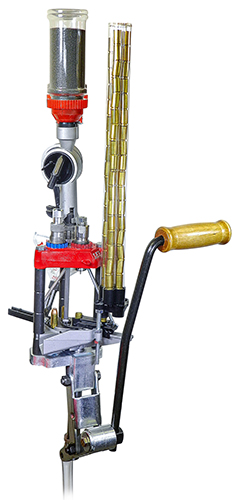
Hornady Lock-n-Load AP (five stations)
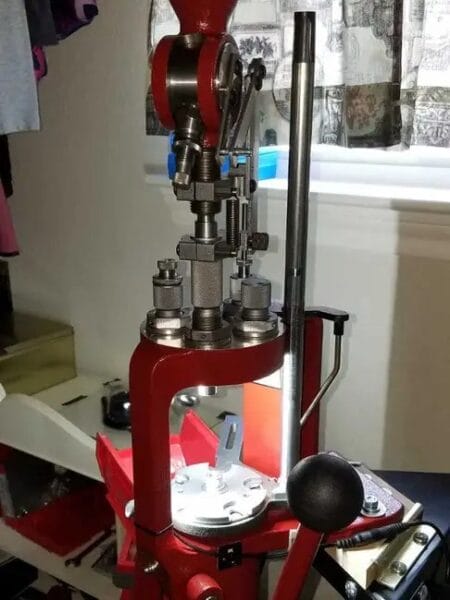
Frankford Arsenal X-10 (ten stations, includes case feeder)
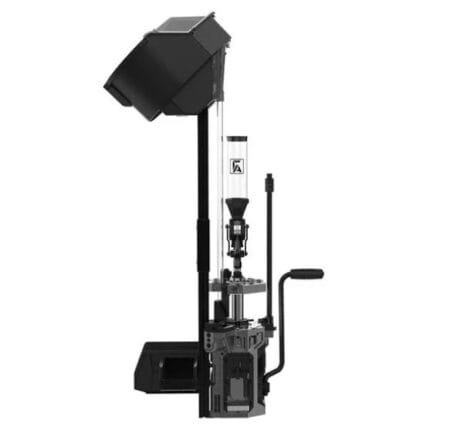
Dillon XL750 (five stations – price includes electric case feeder not shown and other optional accessories (not shown) to make the workflow speedier. This is the set-up I have)
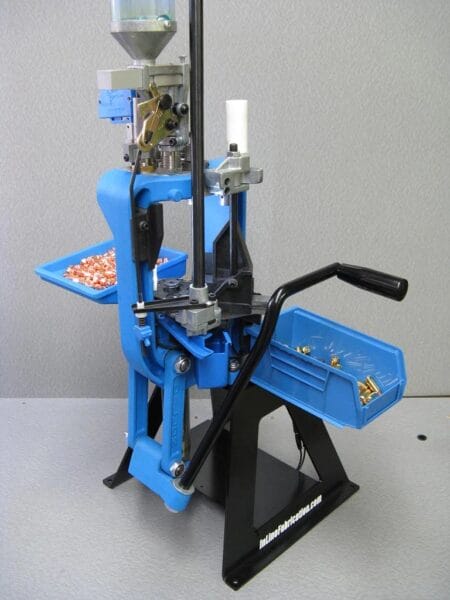
Conclusion
So, you want to move up to a progressive press? Great! You have many choices. As I said above, I’ve shown you some great options, but these are not the only progressive presses out there. After you have figured out what you need, you might consider visiting the links above, reading about the individual presses, watching some videos, and making some decisions.
Regardless of whatever press you end up with, have fun but please follow standard procedures and stay safe as you crank out the ammo. Here’s the benefit of doing so: you will enjoy shooting the baskets of cartridges you’ll make. To answer the question I posed at the very top — yessirree, progressive presses are worth it! Is it time you move up to one?
About Mike Hardesty
With experience spanning over 45 years, Mike Hardesty has long enjoyed shooting and reloading. An inveterate reloader, he casts bullets and reloads for a diverse array of firearms, each handled with long-practiced precision. Living in rural Indiana, his homestead boasts a personal 100-yard range where he shares his love for guns to his four sons, their wives, and eleven grandchildren. As a recognized author, his writings have been featured in notable platforms like Sniper Country, Bear Creek Arsenal Blog, Pew Pew Tactical, TTAG, Dillon Precision’s Blue Press, and Gun Made, revealing his ongoing passion for firearms at the age of 72.
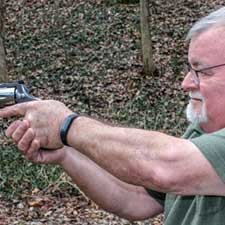
Some of the links on this page are affiliate links, meaning at no additional cost to you, Ammoland will earn a commission if you click through and make a purchase.
Source link: https://www.ammoland.com/2024/03/reloading-101-are-progressive-presses-worth-it/ by Mike Hardesty at www.ammoland.com

